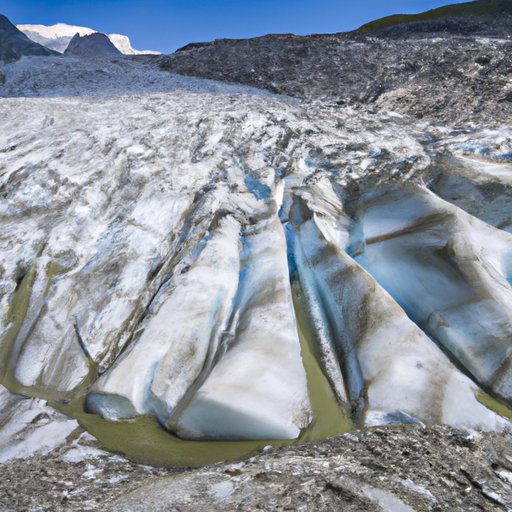Introduction
Glacial erosion is a powerful geologic force that shapes the landscape and affects life. It occurs when glaciers move over the surface of the earth, scraping and gouging the underlying rocks and sediment. This process can create spectacular landforms such as cirques, moraines, and U-shaped valleys. It can also carve out rivers and lakes. In addition, glacial erosion has implications for biodiversity and human populations. This article will explore the different types of glacial erosion, their effects on landforms, and how climate change impacts this process.

Identifying the Different Types of Glacial Erosion
There are three main types of glacial erosion: abrasion, plucking, and freeze-thaw weathering. Abrasion occurs when rocks embedded in the glacier scrape against the underlying rocks and sediment. Plucking occurs when the glacier pulls pieces of rock from the ground as it moves. Freeze-thaw weathering happens when water seeps into cracks in the rock, freezes, and expands, causing chunks of the rock to break off.
Examining the Effects of Glacial Erosion on Landforms
Glacial erosion creates many distinctive landforms. Cirques are bowl-shaped depressions formed by the erosion of ice and snow. Moraines are ridges of debris created by the movement of glaciers. U-shaped valleys are deep valleys carved by glaciers. All of these landforms are evidence of the erosive power of glacial ice.
Investigating the Role of Glaciers in Carving Rivers and Lakes
In addition to creating landforms, glacial erosion plays an important role in carving out rivers and lakes. Glaciers erode both bedrock and sediment, which can result in the formation of new channels. As the glacier melts, the sediment it carries is deposited in the newly formed river or lake, creating new habitats for plants and animals.

Exploring How Climate Change Impacts Glacial Erosion
Climate change has a direct impact on glacial erosion. As temperatures rise, glaciers melt more quickly, resulting in an acceleration of glacial erosion. This can lead to changes in the landscape, including increased flooding and landslides in some areas. In addition, accelerated glacial erosion can cause rivers and lakes to become shallower, resulting in habitat loss for fish and other aquatic species.

Understanding the Interconnectedness of Glacial Erosion and Life
Glacial erosion has a direct impact on biodiversity and human populations. The erosion of bedrock can reduce soil fertility and lead to habitat loss for plants and animals. In addition, the shifting of sediment can cause changes in water flow, leading to disruption of fisheries and other aquatic ecosystems. Furthermore, changes in the landscape caused by glacial erosion can affect human communities, leading to displacement and economic hardship.
Conclusion
Glacial erosion is a powerful geologic process that shapes the landscape and affects life. This article has explored the different types of glacial erosion, their effects on landforms, and how climate change accelerates this process. Glacial erosion has implications for biodiversity and human populations, and understanding its effects is essential for managing the environment responsibly.
(Note: Is this article not meeting your expectations? Do you have knowledge or insights to share? Unlock new opportunities and expand your reach by joining our authors team. Click Registration to join us and share your expertise with our readers.)
